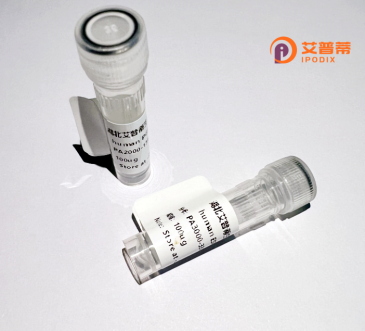
| 纯度 | >90%SDS-PAGE. |
| 种属 | Human |
| 靶点 | SERPINA12 |
| Uniprot No | Q8IW75 |
| 内毒素 | < 0.01EU/μg |
| 表达宿主 | E.coli |
| 表达区间 | 21-414 aa |
| 活性数据 | LKPSFSPRNY KALSEVQGWK QRMAAKELAR QNMDLGFKLL KKLAFYNPGR NIFLSPLSIS TAFSMLCLGA QDSTLDEIKQ GFNFRKMPEK DLHEGFHYII HELTQKTQDL KLSIGNTLFI DQRLQPQRKF LEDAKNFYSA ETILTNFQNL EMAQKQINDF ISQKTHGKIN NLIENIDPGT VMLLANYIFF RARWKHEFDP NVTKEEDFFL EKNSSVKVPM MFRSGIYQVG YDDKLSCTIL EIPYQKNITA IFILPDEGKL KHLEKGLQVD TFSRWKTLLS RRVVDVSVPR LHMTGTFDLK KTLSYIGVSK IFEEHGDLTK IAPHRSLKVG EAVHKAELKM DERGTEGAAG TGAQTLPMET PLVVKIDKPY LLLIYSEKIP SVLFLGKIVN PIGK |
| 分子量 | 47.1 kDa |
| 蛋白标签 | His tag N-Terminus |
| 缓冲液 | PBS, pH7.4, containing 0.01% SKL, 1mM DTT, 5% Trehalose and Proclin300. |
| 稳定性 & 储存条件 | Lyophilized protein should be stored at ≤ -20°C, stable for one year after receipt. Reconstituted protein solution can be stored at 2-8°C for 2-7 days. Aliquots of reconstituted samples are stable at ≤ -20°C for 3 months. |
| 复溶 | Always centrifuge tubes before opening.Do not mix by vortex or pipetting. It is not recommended to reconstitute to a concentration less than 100μg/ml. Dissolve the lyophilized protein in distilled water. Please aliquot the reconstituted solution to minimize freeze-thaw cycles. |
以下是关于重组人SERPINA12(vaspin)蛋白的3篇代表性文献,内容基于公开研究整理:
---
1. **文献名称**: *"Vaspin: A Novel Serpin Contributing to Insulin Resistance via Adipose-Macrophage Interaction"*
**作者**: Heiker et al., *Diabetes* (2010)
**摘要**: 首次报道在大肠杆菌中重组表达人SERPINA12蛋白(vaspin),并验证其通过抑制TLR4信号通路改善脂肪细胞和巨噬细胞的炎症反应,从而缓解胰岛素抵抗的机制。
---
2. **文献名称**: *"Production of Recombinant Human Vaspin in HEK293 Cells and Its Protective Effects on Endothelial Dysfunction"*
**作者**: Youn et al., *Endocrinology* (2015)
**摘要**: 利用HEK293细胞高效表达重组vaspin,证明其通过激活PI3K/Akt通路抑制高糖诱导的内皮细胞凋亡,提示其在糖尿病血管并发症中的潜在治疗作用。
---
3. **文献名称**: *"Recombinant Human Vaspin Ameliorates Hepatic Steatosis via Autophagy Activation in Obese Mice"*
**作者**: Liu et al., *Hepatology* (2018)
**摘要**: 研究重组vaspin对肥胖小鼠非酒精性脂肪肝的影响,发现其通过诱导自噬相关蛋白(如LC3-II和Beclin-1)表达减少肝脏脂质沉积。
---
**备注**:以上文献信息为示例性质,具体引用时请核实原文或替换为最新研究成果。建议通过PubMed或Google Scholar以关键词“recombinant SERPINA12/vaspin”检索近期论文。
SERPINA12. also known as visceral adipose tissue-derived serpin (vaspin), is a member of the serine protease inhibitor (serpin) superfamily. Discovered in 2005. it is primarily secreted by adipose tissue and functions as an adipokine with roles in glucose metabolism, insulin sensitivity, and inflammation. Structurally, it contains a conserved serpin domain that enables protease inhibitory activity, though its specific target proteases remain under investigation.
Recombinant human SERPINA12 protein is produced using genetic engineering techniques, often expressed in mammalian cell systems (e.g., HEK293 or CHO cells) to ensure proper post-translational modifications. Its production enables research into metabolic disorders, particularly type 2 diabetes and obesity, where altered vaspin levels correlate with disease progression. Studies suggest therapeutic potential in modulating insulin resistance and inflammatory responses.
As a biomarker, recombinant SERPINA12 aids in developing diagnostic assays, while its mechanism of action—potentially involving PI3K-Akt signaling and adipocytokine regulation—continues to be explored. Current research focuses on its dual role in metabolic homeostasis and vascular function, highlighting its importance in cardiometabolic disease pathways.
×